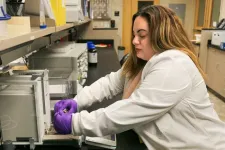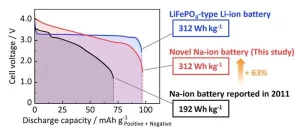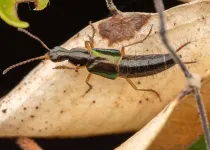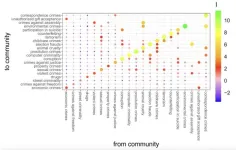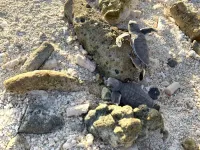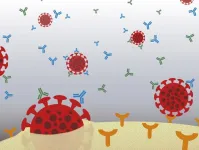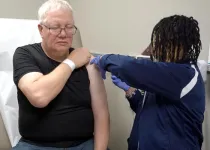(Press-News.org) The way ice forms is a lot more interesting than you think. This basic physical process, among the most common in nature, also remains somewhat mysterious despite decades of scientific scrutiny.
Now new research from the University of Utah, with Germany’s Max Plank Institute for Polymer Research and Idaho’s Boise State University, is shedding fresh light on the role of biological agents—produced by fungi of all things—in ice formation.
Contrary to what we have been taught in school, water won’t necessarily freeze at 0 degrees Celsius (32 degrees F) because of the energy barrier inherent in phase transitions.
Completely pure water won’t freeze until it cools to as low as -46 C. This is because water molecules require particles on which to build the crystals that lead to ice, a process called nucleation. Organisms have evolved various ways to control ice formation as an adaption to survive in cold environments.
So the most efficient ice-nucleating particles are biological in origin, produced in bacteria and fungi, and even insects, but the molecular basis and precise mechanisms of “biological ice nuclei” has not been well understood.
A fungus’ ability to control ice
Valeria Molinero, a theoretical chemist with the University of Utah’s College of Science, is at the forefront of sorting out this mystery, which holds potential implications for improving our understanding of how life affects precipitation and climate.
In a new study, she co-led, an international team of researchers explores the characteristics and properties of fungal ice nucleators, revealing that they are made up of small protein subunits and play a role in both promoting and inhibiting ice growth.
“They are proteins that are excreted to the environment and these particles are extremely effective for ice nucleation,” said Molinero, director of the the university’s Henry Eyring Center for Theoretical Chemistry. “But the way the organism benefits from these ice nucleation abilities is not known and it doesn’t exist in all the possible variants of the organism. We don’t know why they form ice or whether there’s an advantage.”
The multidisciplinary team homed in on a species of fungus called Fusarium acuminatum and discovered it produces ultra-minute proteins that aggregate into larger particles. Their findings are published this week in the Proceedings of the National Academy of Sciences, or PNAS.
According to co-lead author Konrad Meister, the mechanism of forming larger aggregates from smaller building blocks is found in other organisms besides fungi.
“Nevertheless, we were surprised by the small size of the fungal protein building blocks compared to their efficiency,” said Meister, a professor of chemistry at Boise State. “Other known and similarly efficient ice-making proteins from other organisms, for example, are 25 times larger.”
How organisms evolve in different ways to achieve the same outcome
Bacteria and fungal proteins can spur ice formation at temperatures as warm as -10 to -2 degrees. Some bacteria are so effective at promoting ice that they are put to work in products ski areas use for snowmaking.
Molinero is intrigued that so many different kinds of organisms have evolved similar ice-nucleating capabilities that she originally titled the paper “E pluribus unum,” meaning “out of many, one,” but the journal insisted they drop the Latin.
“If you look across kingdoms that can nucleate ice, there are insects, lichen, bacteria and fungi. All of these seem to have evolved independently, very potent ice nucleants” she said. “And all of the ice nucleation in nature that is extremely effective seems to be done by proteins, although the size of the individual ice nucleating proteins vary a lot among organisms.”
The ecological advantages of ice nucleation and its role in cloud formation and precipitation are not yet fully understood and pose a significant gap in our grasp of the interplay between climate and life, according to the study. The research can lead to improving the efficiency of food-freezing process, snowmaking or cloud seeding.
With the team’s discoveries come many more questions, however, such as why and how do these proteins aggregate.
“The other question is whether they’re doing this on purpose or is it just that there’s a protein that they produce for something else, but it has this property,” said Molinero.
Resolving these fundamental questions will require teamwork, bringing together investigators with expertise in various areas of chemistry, biophysics and biology.
“This is the positive message. Solving the puzzle of biological control of ice formation drives scientists to collaborate,” Molinero said. “Each of us has a piece of the knowledge, but altogether we can do so much. It’s been fun.”
Published Nov. 9 in PNAS under the title “Functional aggregation of cell-free proteins enables fungal ice formation,” this research was funded by grants from the National Science Foundation, National Institutes of Health and the U.S. Air Force Office of Scientific Research.
Valeria Molinero is the Jack and Peg Simons Endowed Professor of Theoretical Chemistry and director of the University of Utah’s Henry Eyring Center within the Department of Chemistry. Ingrid de Almeida Ribeiro, a postdoctoral researcher in the Molinero lab, is the co-first author of this study.
END
Forming ice: There’s a fungal protein for that
University of Utah chemist Valeria Molinero is helping unravel the mysteries of how water becomes solid
2023-11-13
ELSE PRESS RELEASES FROM THIS DATE:
TTUHSC’s Wilkerson to investigate links between pain and basal sex hormone levels
2023-11-13
For most patients, acute pain following a surgical procedure is a common and expected hurdle which is eventually cleared during recovery. However, there is a small but significant patient population that experiences chronic post-surgical pain that may linger for six months or longer.
Sex hormones (e.g., estrogen in females and testosterone in males) are generally regarded as contributors to post-surgical pain development and maintenance, and basal sex hormones are the range of sex hormones expected to be produced in a healthy individual at any point in time. When basal sex ...
Template for success: Shaping hard carbon electrodes for next-generation batteries
2023-11-13
Lithium-ion batteries (LIBs) are, by far, the most widely used type of rechargeable batteries, spanning numerous applications. These include consumer electronics, electric vehicles (e.g., Tesla cars), renewable energy systems, and spacecrafts. Although LIBs deliver the best performance in many aspects when compared to other rechargeable batteries, they have their fair share of disadvantages. Lithium is a rather scarce resource, and its price will rise quickly with its availability going down in the future. Moreover, lithium extraction and improperly discarded LIBs pose huge environmental challenges as the liquid electrolytes commonly used in them are toxic and ...
New beetle species has bottle-opener shaped genitalia: Now that calls for a Carlsberg!
2023-11-13
Penises are more prevalent in some lines of work than others. And for researchers who study biodiversity of insects, penises play a significant role in their daily workload – for good reason.
"Genitalia are the organs in insects that evolve to be different in every species. As such, they are often the best way to identify a species. That's why entomologists like us are always quick to examine insect genitalia when describing a species. The unique shape of each species’ genitals ensures that it can only reproduce with the same species," explains biologist Aslak Kappel Hansen of the ...
New scientific methods for analyzing criminal careers
2023-11-13
Researchers at the Complexity Science Hub have examined 1.2 million criminal incidents and developed an innovative method to identify patterns in criminal trajectories.
When it comes to preventing future crimes, it is essential to understand how past criminal behavior relates to future offenses. One key question is whether criminals tend to specialize in specific types of crimes or exhibit a generalist approach by engaging in a variety of illegal activities.
Despite the potential significance of systematically identifying patterns in criminal careers, especially in preventing ...
Endangered turtle population under threat as pollution may lead to excess of females being born
2023-11-13
Green sea turtles, Chelonia mydas, are listed as endangered on the IUCN Red List of Threatened Species. They are at risk of extinction due to poaching, collisions with boats, habitat destruction, and accidental capture in fishing gear. But another threat, linked to climate change, is more insidious: sea turtles have temperature-dependent sex determination, which means that more and more embryos develop into females as temperatures keep rising. Already, in the northern part of the Great Barrier Reef off Australia, hundreds of females are born for ...
Your reaction matters: the role of antibodies in Covid-19 response
2023-11-13
Efforts to contain the Covid-19 pandemic have largely focused on vaccine development and deployment. But how exactly do our immune systems respond to COVID-19 vaccines? The major response occurs in one of two ways: the production of antibodies that bind to the receptor-binding domain (RBD) or the production of antibodies that bind to the N-terminal domain (NTD) of the coronavirus viral spike protein. Both play important roles in preventing infection, pathogenesis, and severe disease. However, the antibody repertoire varies widely among individuals. While it has been suggested that this diversity in antibodies influences the ability to ...
Survey finds many Americans are letting their guard down during respiratory illness season
2023-11-13
COLUMBUS, Ohio – Despite the Centers for Disease Control and Prevention warning this year will be potentially dangerous for respiratory illnesses, a third of Americans are not concerned about the threat, according to a new national survey by The Ohio State University Wexner Medical Center.
The survey found that while the majority of those polled (87%) said they do everything they can to avoid spreading seasonal viruses, one-third think their vaccine decision doesn’t affect others and that they don’t need ...
New research maps 14 potential evolutionary dead ends for humanity and ways to avoid them
2023-11-13
For the first time, scientists have used the concept of evolutionary traps on human societies at large. They find that humankind risks getting stuck in 14 evolutionary dead ends, ranging from global climate tipping points to misaligned artificial intelligence, chemical pollution, and accelerating infectious diseases.
The evolution of humankind has been an extraordinary success story. But the Anthropocene — the proposed geological epoch shaped by us humans — is showing more and more cracks. Multiple global crises, such as the Covid-19 pandemic, climate change, food insecurity, financial crises, and conflicts have started to occur simultaneously ...
Lepodisiran, an extended-duration short interfering RNA targeting lipoprotein(a)
2023-11-12
About The Study: In this phase 1 study of 48 participants with elevated lipoprotein(a) levels, lepodisiran was well tolerated and produced dose-dependent, long-duration reductions in serum lipoprotein(a) concentrations. The findings support further study of lepodisiran, which is a short interfering RNA directed at hepatic synthesis of apolipoprotein(a), an essential component necessary for assembly of lipoprotein(a) particles.
Authors: Steven E. Nissen, M.D., of the Cleveland Clinic Center for Clinical Research in Cleveland, is the ...
Trial shows a single dose of an experimental therapy reduces lipoprotein(a), an important heart disease risk factor, more than 94% for nearly a year
2023-11-12
Cleveland: Findings from a phase 1 trial reported by a Cleveland Clinic physician show that a single dose of an experimental therapy produced greater than 94% reductions in blood levels of lipoprotein(a), a key driver of heart disease risk, with the results lasting for nearly a year.
Results from the “Efficacy and Safety of Lepodisiran: An Extended Duration Short-Interfering RNA Targeting Lipoprotein(a) Study” were presented today during a late-breaking science session at the American Heart ...
LAST 30 PRESS RELEASES:
Safety decision-making for autonomous vehicles integrating passenger physiological states by fNIRS
Fires could emit more air pollution than previously estimated
A new way to map how cells choose their fate
Numbers in our sights affect how we perceive space
SIMJ announces global collaborative book project in commemoration of its 75th anniversary
Air pollution exposure and birth weight
Obstructive sleep apnea risk and mental health conditions among older adults
How talking slows eye movements behind the wheel
The Ceramic Society of Japan’s Oxoate Ceramics Research Association launches new international book project
Heart-brain connection: international study reveals the role of the vagus nerve in keeping the heart young
Researchers identify Rb1 as a predictive biomarker for a new therapeutic strategy in some breast cancers
Survey reveals ethical gaps slowing AI adoption in pediatric surgery
Stimulant ADHD medications work differently than thought
AI overestimates how smart people are, according to HSE economists
HSE researchers create genome-wide map of quadruplexes
Scientists boost cell "powerhouses" to burn more calories
Automatic label checking: The missing step in making reliable medical AI
Low daily alcohol intake linked to 50% heightened mouth cancer risk in India
American Meteorological Society announces Rick Spinrad as 2026 President-Elect
Biomass-based carbon capture spotlighted in newly released global climate webinar recording
Illuminating invisible nano pollutants: advanced bioimaging tracks the full journey of emerging nanoscale contaminants in living systems
How does age affect recovery from spinal cord injury?
Novel AI tool offers prognosis for patients with head and neck cancer
Fathers’ microplastic exposure tied to their children’s metabolic problems
Research validates laboratory model for studying high-grade serous ovarian cancer
SIR 2026 delivers transformative breakthroughs in minimally invasive medicine to improve patient care
Stem Cell Reports most downloaded papers of 2025 highlight the breadth and impact of stem cell research
Oxford-led study estimates NHS spends around 3% of its primary and secondary care budget on the health impacts of heat and cold in England
A researcher’s long quest leads to a smart composite breakthrough
Urban wild bees act as “microbial sensors” of city health.
[Press-News.org] Forming ice: There’s a fungal protein for thatUniversity of Utah chemist Valeria Molinero is helping unravel the mysteries of how water becomes solid
